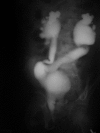Laparoscopic undiversion in a child with sacral agenesis into augmentation cystoplasty
- PMID: 24018085
- PMCID: PMC3771767
- DOI: 10.4293/108680813X13693422522079
Laparoscopic undiversion in a child with sacral agenesis into augmentation cystoplasty
Abstract
Introduction: In neurogenic bladder with compromised renal function or when complex reconstruction is not preferred, ileal conduit is considered. Undiversion is performed when the patient prefers the procedure, once the renal function improves, or when complications resulting from diversion are present.
Case description: We present the case of a 10-y-old boy with sacral agenesis, who underwent laparoscopic-assisted ileal conduit diversion in 2006, because he had a grossly unstable, small-capacity bladder and was not compliant with intermittent self-catheterization. At present, he preferred not to have a conduit.
Discussion: Laparoscopic undiversion with ileal augmentation cystoplasty was performed. The postoperative course was uneventful, and he is now on intermittent self-catheterization with healthy renal function. Laparoscopic undiversion is technically challenging, yet feasible, and is an effective option in children. To our knowledge, this is the first such case reported.
Figures






Similar articles
-
Experiences with urinary undiversion in children with neurogenic bladder.J Urol. 1980 Mar;123(3):402-6. doi: 10.1016/s0022-5347(17)55957-1. J Urol. 1980. PMID: 7359645
-
Experiences with urinary undiversion in children with neurogenic bladder.Trans Am Assoc Genitourin Surg. 1979;71:134-9. Trans Am Assoc Genitourin Surg. 1979. PMID: 545804
-
Laparoscopy-assisted ileal conduit in sacral agenesis.J Laparoendosc Adv Surg Tech A. 2008 Apr;18(2):335-9. doi: 10.1089/lap.2007.0041. J Laparoendosc Adv Surg Tech A. 2008. PMID: 18373472
-
The neurogenic bladder and incontinent urinary diversion.Urol Clin North Am. 2010 Nov;37(4):581-92. doi: 10.1016/j.ucl.2010.07.003. Urol Clin North Am. 2010. PMID: 20955909 Review.
-
[Bladder augmentation and urinary diversion in children and adolescents].Urologe A. 2016 Jan;55(1):44-52. doi: 10.1007/s00120-015-0006-0. Urologe A. 2016. PMID: 26660301 Review. German.
Cited by
-
The potential utility of non-invasive imaging to monitor restoration of bladder structure and function following subtotal cystectomy (STC).BMC Urol. 2015 Oct 14;15:103. doi: 10.1186/s12894-015-0094-6. BMC Urol. 2015. PMID: 26463481 Free PMC article.
References
-
- McDougal WS. Use of intestinal segments and urinary diversion. In: Walsh PC, Retik AB, Vaughan ED, Jr., Wein AJ, eds. Campbell's Urology, 8th ed Philadelphia: WB Saunders; 2002;3771
-
- Ramalingam M, Senthil K, Pai MG. Modified technique of laparoscopy-assisted surgeries (transportal). J Endourol. 2008;22:2681–2685 - PubMed
-
- Robertson CN, King LR. Bladder substitution in children. Urol Clin North Am. 1986;13:333–344 - PubMed
-
- Wolf JS, Jr., Taheri PA. Laparoscopic urinary undiversion. J Urol. 1998;159:198–199 - PubMed
Publication types
MeSH terms
LinkOut - more resources
Full Text Sources
Other Literature Sources
